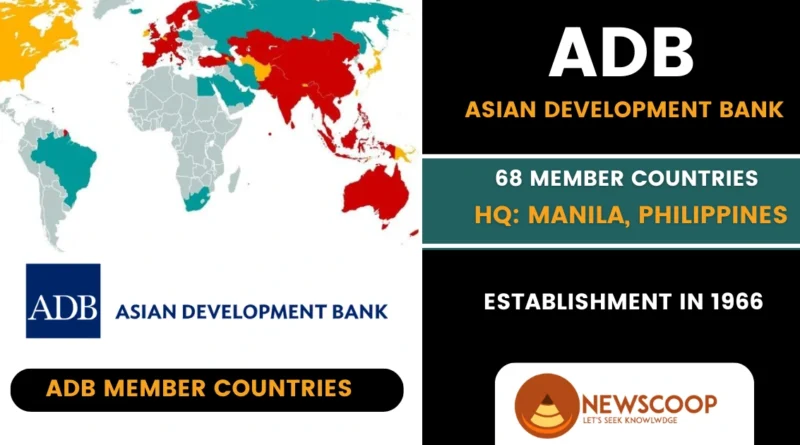Asian Development Bank (ADB): Objectives & Functions
The Asian Development Bank (ADB) is an international financial institution that promotes economic growth, social progress, and poverty reduction in the Asia-Pacific region. Established in 1966, ADB has played a crucial role in fostering sustainable development and regional cooperation.
This article overviews the Asian Development Bank and its significance for the Union Public Service Commission (UPSC) examinations.
Asian Development Bank (ADB)
ADB stands for the Asian Development Bank. It is an international financial institution that was established in 1966. ADB’s primary purpose is to promote economic growth, social progress, and poverty reduction in the Asia-Pacific region. Further, it provides financial assistance, technical expertise, and policy advice to its member countries.
Moreover, ADB focuses on priority areas such as infrastructure development, education, healthcare, and environmental sustainability. By fostering regional cooperation and supporting sustainable development initiatives, ADB aims to improve people’s lives in the Asia-Pacific region.
Motto: “Committed to achieving a prosperous, inclusive, resilient, and sustainable Asia & the Pacific, while sustaining its efforts to eradicate extreme poverty.”
Membership of the Asian Development Bank (ADB)
Since its establishment in 1966 with 31 members, the Asian Development Bank (ADB) has significantly expanded its membership. Currently, ADB contains 68 members:
- 49 from the Asia-Pacific region
- 19 from outside the region.
As of 31 December 2022, the five largest shareholders of the Asian Development Bank (ADB) are:
- Japan: Holds 15.6% of total shares.
- United States: Holds 15.6%
- China: Holds 6.4%
- India: Holds 6.3%
- Australia: Holds 5.8%
These countries have significant ownership in ADB, reflecting their commitment and involvement in the bank’s operations and decision-making processes.
Voting Rights of Member Countries
Voting power in the Asian Development Bank (ADB) is determined by the shareholding of member countries. The more shares a country holds, the more voting power it has.
Countries like Japan and the United States, which have larger economies and contribute more to ADB, have higher voting power. The People’s Republic of China, India, and Australia also hold significant voting power.
The voting power of each country influences decision-making in ADB, including policies, projects, and resource allocation. It’s important to note that the exact distribution of voting power may change over time as countries’ contributions and shareholdings in ADB evolve.
Headquarters
The headquarters of the Asian Development Bank (ADB) is located in Manila, the capital city of the Philippines. Manila was chosen as the headquarters for ADB at its establishment in 1966. The headquarters serve as the central hub for ADB’s operations, decision-making processes, and coordination with member countries.
Objectives of ADB
The Asian Development Bank (ADB) has the following objectives:
- Promote economic growth in the Asia-Pacific region.
- Reduce poverty and improve livelihoods.
- Enhance social development and inclusiveness.
- Foster regional cooperation and integration.
- Ensure environmental sustainability and address climate change.
- Support good governance and transparency.
Also Read: 10 ASEAN Countries
History of the Asian Development Bank (ADB)
ADB, the Asian Development Bank, was conceived in the early 1960s with the vision of being an institution that would reflect the character of Asia and promote economic growth and cooperation in one of the world’s poorest regions. The idea of establishing ADB emerged from the first Ministerial Conference on Asian Economic Cooperation, held by the United Nations Economic Commission for Asia and the Far East (ESCAFE) in 1963.
In recognition of its potential impact, Manila, the capital of the Philippines, was chosen as the headquarters for the newly formed institution. At its inception, ADB had 31 member countries, each contributing to the bank’s efforts to foster development in the Asia-Pacific region.
Takeshi Watanabe, a Japanese economist, served as ADB’s first President. Under his leadership, ADB began its journey of supporting development initiatives in the region.
During the 1960s, ADB primarily focused on food production and rural development as key areas for assistance. It aimed to improve agricultural productivity, enhance rural infrastructure, and address the pressing challenges of poverty and food security in the region.
In subsequent years, ADB expanded its scope and diversified its operations. It ventured into various sectors, including education, healthcare, infrastructure, finance, and environmental sustainability. ADB’s lending programs, technical assistance, and policy advice played a crucial role in supporting the development efforts of its member countries.
Focus Areas
ADB provides knowledge and expertise to tackle the following focus areas:
- Agriculture and Food Security
- Climate Change and Disaster Risk Management
- Digital Technology
- Education
- Energy
- Environment
- Finance
- Fragility and Vulnerability
- Gender and Development
- Governance
- Health
- Public-Private Partnerships
- Regional Cooperation and Integration
- Social Development and Poverty
- Sustainable Development Goals
- Transport
- Urban Development
- Water
Structure & Functions of the Asian Development Bank
The structure of the Asian Development Bank (ADB) consists of the following components:
- Board of Governors
- Board of Directors
- President
- Regional Departments
- Sector and Thematic Groups
- Independent Evaluation Department
- Support Units (e.g., Office of Administrative Services, Office of the General Counsel, Office of Risk Management)
Board of Governors: The highest decision-making body of ADB, composed of representatives from all member countries. The Board of Governors meets annually to discuss policies, strategies, and financial matters.
Board of Directors: Responsible for the day-to-day operations and decision-making of ADB. The Board of Directors is composed of 12 members, including the President of ADB, and represents different geographical constituencies.
President: The President of ADB is the chief executive officer and is responsible for the overall management and administration of the bank. The President is appointed by the Board of Governors and leads the strategic direction of ADB.
Regional Departments: ADB is organized into several regional departments that focus on specific geographic areas, such as East Asia, Southeast Asia, South Asia, Central and West Asia, and the Pacific. These departments are responsible for project identification, implementation, and coordination with member countries.
Sector and Thematic Groups: ADB has sector and thematic groups that specialize in various development sectors, such as agriculture, education, energy, transport, water, and urban development. These groups provide technical expertise, policy guidance, and project support in their respective areas.
Independent Evaluation Department: ADB has an independent evaluation department that assesses the effectiveness, efficiency, and impact of ADB’s projects and programs. It provides an independent perspective on ADB’s operations and helps improve its performance.
Support Units: ADB has various support units that provide administrative, financial, and operational support to ensure the smooth functioning of the organization. These units include the Office of Administrative Services, the Office of the General Counsel, and the Office of Risk Management.
Conclusion
In conclusion, the Asian Development Bank (ADB) is a vital institution that promotes economic growth, poverty reduction, and social progress in the Asia-Pacific region.
With its focus on key areas such as infrastructure, poverty reduction, climate change, and regional cooperation, ADB plays a significant role in advancing sustainable development and improving the lives of people in its member countries. Through its financial support, technical expertise, and strategic partnerships, ADB continues to make a positive impact and contribute to the region’s development goals.
Thank You!

